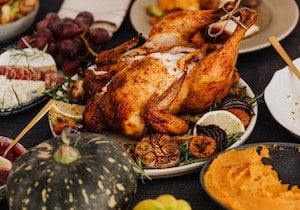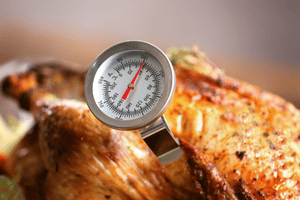
1. Wash Everything, Except the Turkey!
- Wash hands before, during and after food preparations.1 Dry hands on a separate towel (not the one for dishes) or a clean paper towel.
- Wash all produce (whether you eat the skin or not) thoroughly under running water before preparing and/or eating. This includes produce grown at home or bought from a grocery store or farmers’ market. If the produce surface is rough like an avocado or melon, use a vegetable brush to lightly scrub the surface without bruising
- Don’t rinse your turkey or any poultry! Rinsing your turkey can spread harmful germs and bacteria around the kitchen and increases the risk of cross-contamination.

- Use a thermometer! And you need two: a meat thermometer and an instant read one!
- For cooking meats, like turkey, a meat thermometer is a must. Whole poultry products, like turkeys, need to be baked to an internal temperature of 165°F to ensure the turkey is safe. When cooking a whole turkey, check the temperature in at least three places: the innermost part of the thigh, the innermost part of the wing and the thickest part of the breast.2
- Use an instant read food thermometer to make sure hot foods are cooked to an internal temperature that kill germs — at least 140 degrees.
- Thanksgiving leftovers are the best but to keep safe, heat to the internal temperature of 165 degrees.
- When it comes to cooking foods, high temperatures are a good thing!
3. Stuff Yourself, Not the Bird
- Whether it’s stuffing or dressing, it’s better to keep in a separate dish than in the turkey.
- But if it’s a tradition, follow these steps: If using raw meat, poultry, or shellfish, cook ingredients before stuffing the turkey. This will reduce the risk of food-borne illness from potential bacteria found in raw ingredients. Wet ingredients for stuffing can be prepared ahead of time and refrigerated. Mix wet and dry ingredients together just before spooning the stuffing mixture into the turkey cavity. Immediately place the stuffed, raw turkey in an oven set no lower than 325 degrees.3
- Do not stuff whole poultry with cooked stuffing.
- Do not stuff turkeys to be grilled, smoked, fried or microwaved.
- And finally, don’t really stuff yourself with dressing … just enjoy the annual tradition.

- Thanksgiving and any holiday celebrations can last for hours but perishable food cannot! Refrigerate perishable food and leftovers within two hours of serving. If room or outside temperature is above 90 degrees, refrigerate after one hour.
- Refrigerate leftovers in shallow pans to allow for quick and even cooling. Cooling to room temperature on a countertop before chilling is not safe regardless of what you’ve been told. 3
- Leftovers are to be savored! Eat refrigerated leftovers within 3-4 days or freeze to prevent waste and spoilage. Food items, like turkey, can be frozen for 3-4 months without sacrificing quality.
5. Celebrate the Season
- Enjoy friends and family. Make time to share with others.
- Remember, hosting post-Thanksgiving gatherings can be simple and you can rock your leftovers with great ideas from Rosanne Rust, MS, RDN.4
- Keeping food safe and preventing food waste are core to a festive holiday season. Have a safe and joyous holiday season!
References
1. Food Safety for the Holidays, Centers for Disease Control, November 24, 2021.
2. Food Safety When Cooking with Turkey, National Turkey Federation.
3. Turkey Basics: Stuffing, U.S. Department of Agriculture, Food Safety and Inspection Service. July 31, 2013.
4. 8 Ways to Rock Your Holiday Leftovers, by Rosanne Rust, MS, RDN, Rust Nutrition, November 17, 2022.
